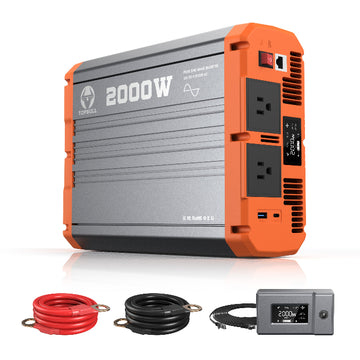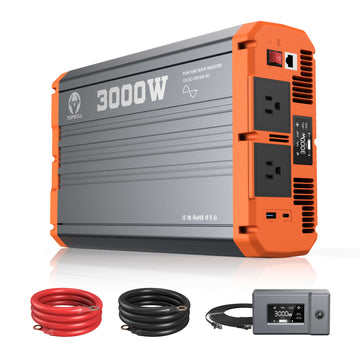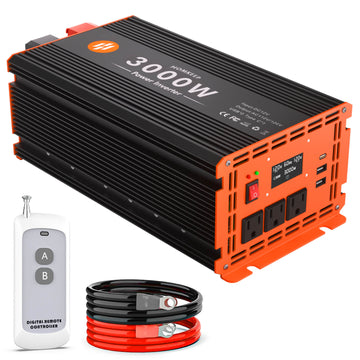Whether you're looking to power a weekend RV trip, prepare for a storm outage, or build an off-grid solar system, understanding the difference between an inverter and an inverter charger is critical to avoiding costly mistakes. While both devices convert DC battery power into usable AC power, their functions and ideal applications are quite different.
What is an inverter?
An inverter is an essential power conversion device that converts direct current (DC) from sources such as batteries or solar panels into alternating current (AC)-the type of electricity used by most household appliances and electronics. However, it relies on a separate battery and cannot recharge itself.
What is an inverter charger?
An inverter charger is a hybrid device that combines two critical functions in one unit:
- Inverting: Converts DC power from batteries (e.g., 12V/24V/48V) to AC power (120V/240V) for household appliances.
- Charging: Converts AC power from the grid or a generator back to DC to recharge your batteries—automatically and efficiently.
Unlike basic inverters, it acts as a bidirectional power hub, ensuring seamless energy flow whether you’re drawing from batteries or replenishing them.
Key differences between inverter chargers and inverters
The main difference is in function. Although both devices can convert DC to AC. However, they only have a one-way conversion function, while the inverter charger integrates a two-way conversion function (DC⇄AC), which can simultaneously power the device and charge the battery for energy self-sufficiency.
Application scenarios
| Scenarios | Inverter | Inverter Charger |
| Caravan Traveling | Supports only short-term power use | Supports high power consumption devices such as air conditioners, microwave ovens, etc., and can be quickly recharged through the campground power grid |
| Home Backup Power | Manual power switching required, no automatic charging function | Seamless switching + automatic charging for continuous operation of medical equipment, refrigerators, etc. |
| Off-grid solar system | Requires additional charge controller | Built-in MPPT charger, directly manages solar panel input. |
Maintenance:
Inverter chargers require regular and specialized maintenance, which is complicated and costly.
Inverter maintenance is simpler and can be done by the user.
Learn More: Power Inverter Repair & Maintenance: Essential Tips for Efficiency
Cost:
Inverter chargers cost more upfront and require specialized electrician wiring. However, smart charging extends battery life and is more cost-effective in the long run
Low initial cost of inverter, no labor cost.
How to choose the right solurion
1. Define your key usage scenarios
Analyze your power needs, do you need "stand alone" or "integrated charging and storage"?
Inverter charger selection scenarios:
Simultaneous grid charging (e.g. to a household outlet), solar charging (photovoltaic input) and generator charging are required.
Continuous operation of critical equipment, such as medical equipment (e.g., oxygen machines), home security systems, intelligent temperature control, etc., where power outages are not permitted.
Inverter selection scenarios:
📍Camping & Outdoor activities
- Basic power: camping light, cell phone/camera charger, portable speakers
- Comfort upgrade: 12V portable refrigerator (to keep food cold), small electric blanket (to cope with cold nights)
- Entertainment: Mini Projector, Car Coffee Maker
Recommended: Topbull 2000W Pure Sine Inverter

- Multi-device compatibility: 2 AC outlets + Type-C/USB-C fast charging ports (supports PD 45W)
- IP65 waterproof and dustproof (can withstand heavy rain/sandstorm)
- Aluminum case for heat dissipation, -20°C to 60°C wide operating temperature range
📍Temporary emergency power
Power medical equipment, routers, or lighting systems from a car battery in the event of a power outage.
Recommended: Topbull 3000W pure sine wave inverter

- 7 built-in protection mechanisms
- Dual LCD displays to monitor the working status of the inverter
- Wired remote control, convenient for remote control
📍Small household appliances
Provide pure power to precision electronics without interference, eliminating damage caused by voltage fluctuations.
Recommended: Topbull 4000W Pure Sine Inverter

- Medical grade pure output: THD <1.5%, passes IEEE 519 power quality standard.
- Intelligent standby mode: no-load power consumption of only 2W (80% less than traditional models)
- Silent design: only 29dB for night study use
2. Budget comparison
Compare the upfront and long-term investment costs of the two devices.
Initial cost
| Inverter | Inverter Charger | |
| Equipment Price | 200-400 | 1,200-2,800 |
| Installation Cost | DIY available (<$30 tool fee) | Professional electrician required ($300) |
| Required Accessories | Battery cable ($25) | Battery cable ($50) + transfer switch ($120) |
| Total Inital Cost | 255-455 | 1,670-3,270 |
Long-term holding costs
| Inverter | Inverter Charger | |
| Battery Replacement Cycle | 1 time in 8-10 years ($800) | 1 time in 12-15 years ($800) |
| Electricity Loss | $15/month | Intelligent charging saving $8/month |
| Amount saved | - | $1,600 |
The inverter charger saves more money in the long run.
3. Comparison of installation complexity
Traditional inverters are typically plug-and-play with an extremely simple installation process. Users simply need to connect the battery clamps (red positive, black negative) to the car or stand-alone battery pack, then plug the unit into a standard outlet to complete the installation. No special electrical knowledge is required, making it ideal for DIY enthusiasts.
In contrast, installing an inverter charger requires professional intervention and the installation process is more complicated.
Common misconceptions about inverters and inverter chargers
❌The more power, the better. It's always better to just buy the highest wattage.
Truth: Oversized inverters lose efficiency at low loads. Higher wattage models usually require thicker wiring, which increases installation costs.
❌All inverters support solar power, just plug in a PV panel and go!
Truth: Basic inverters do not have MPPT/PWM controllers, connecting directly to solar panels can burn out the circuit. Ordinary inverters need to buy additional solar controller.
❌Inverter chargers are complicated to maintain, not as worry-free as regular inverters
Truth: Some smart inverter chargers have self-test function, 90% maintenance can be done remotely.
❌Lead acid and lithium batteries can be mixed in the same charger.
Truth: Lead-acid batteries need 14.4V to be fully charged, while lithium batteries need 14.6V, mixing will lead to overcharging explosion or undercharging loss.
❌Switching time is not important, a short power outage will not affect the device.
Truth: Slow switching time can be risky for some devices, such as medical ventilators, smart home hubs.
❌The higher the price, the better the quality of the inverter charger.
Truth: Some brands have serious price premiums of up to 40%. Topbull inverters are cost-effective options.













